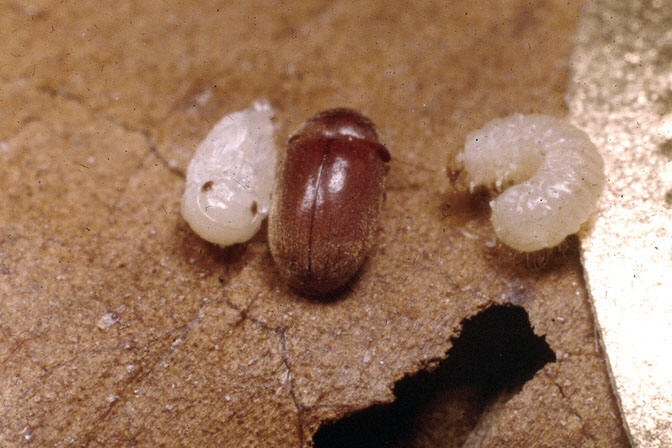All boxes of Habanos include a flyer with this statement:
"For fullest enjoyment, these cigars should be stored in a
humidor, away from products with strong odour and under correct
conditions of temperature (16ºC to 18ºC) and relative humidity (65% to 70%)."
Control of these two factors (temperature and relative humidity) is the key to the proper storage of cigars.
Temperature
The upper limit of temperature for cigar storage is 18ºC (65ºF), as sustained periods above this temperature will allow any dormant Tobacco Beetles to hatch and become active.
Sustained temperatures below 15ºC (59ºF) will slow down the chemical processes that happen in a cigar that is stored for a long period time ("ageing").
It is also important to understand the relationship between temperature and relative humidity. Relative humidity is a measure of the amount of water vapour contained in air, expressed as a percentage of the maximum amount that the air could contain before that water became liquid (the dew point). Warmer air can contain more water vapour than cooler air, so as the temperature increases, more water will need to be released into that air to maintain the same relative humidity. As a rule of thumb, the relative humidity will drop by a factor of two for each 20ºF or 10ºC increase in temperature.
Maintaining stable temperature, therefore, is a critical first step to maintaining stable relative humidity. For this reason, a cigar storage vessel should never be subject to direct sunlight. Glass windows in humidors are also generally inadvisable.
Humidity
The humidity level in a cigar when it is smoked will have an affect on the temperature and consistency of the burn, as well as the tightness of the draw. Both of these factors will have a significant affect on the flavour. The humidity level that a cigar is stored at will have an affect on the ageing process occours within the cigar.
High humidity can cause the growth of mould or cracking of the wrapper. Sustained humidity above 75% can be considered critical.
Low humidity can allow cigars to dry out, causing cracking of the wrapper leaf, evaporation of oils, and loss of flavour. Sustained humidity below 60% should be considered critical.
Most domestic digital hygrometers are only accurate to plus or minus 2% and should be recalibrated every six months.
Odours
Cigars are a porous natural substance, and will absorb flavours from strong odours in their environment. Generally, it is advisable to take care to avoid storing cigars near malodorous substances like paint, varnish, petrol etc, and to make sure that any plastics used are stable and free from manufacturing residue (food-safe is a useful guide). Conversely, certain odiferous substances are considered beneficial to cigars; most notably the cedar wood that is used in cigar boxes and humidors.
Beyond those general rules, it is up to each cigar smoker to determine what environment they prefer for storing their cigars. Many aficionados store cigars they intend to smoke in the near term under different conditions to those they plan to keep for a longer period.
Humidors and Other Storage Vessels
Cigars are typically stored in a humidor. These can range from a small desktop box holding fifty cigars, to climate controlled rooms holding many thousands.
The traditional construction or lining material for humidors is Spanish Cedar (Cedrela Odorata).
Spanish Cedar is not from Spain but from Brazil and other South
American countries and is also called South American Cedar or sometimes Cigar Box Cedar.
Other timbers used are American (or Canadian) Red Cedar (Thuja Plicata)
or
Honduran Mahogany (Swietenia Macrophylla).
Spanish Cedar is highly hygroscopic, meaning that it has a high capacity for water absorption (while remaining stable at high moisture levels), and so, once seasoned, aids in the maintenance of humidity levels where it is present.
The aromatic fragrance is generally thought to add a pleasant flavour to cigars over time.
Some have argued that this fragrance also helps suppress tobacco beetle, but there is little evidence to support this.
Ultimately, any airtight container which can maintain a stable temperature and humidity is appropriate for storing cigars. Many aficionados use electric wine fridges, plastic storage bins (colloquially "Tupperdors," these will ideally be food-safe and IP rated for air and water tightness) or ice boxes ("Coolerdors") when their cigar collection has grown to the point where purpose built humidor storage would be too costly.
Within storage vessels a variety of humidity maintenance devices can be used including electronic humidifiers, treated silica beads and gels, salt packs, and sponges.
Storing cigars in their original boxes is recommended, rather than on open display shelves.
This protects the cigars from light and it is argued that confinement in boxes results in better aging. The hygroscopic nature of the wooden boxes will also create microclimates, which will aid humidity stability when the humidor is opened for a short period. Some cigar collectors vacuum-seal their boxes to exacerbate this effect.
Habanos S.A. recommends removing cigars from their tubes for long term storage. Min Ron Nee, in his book An Illustrated Encyclopaedia of Post-Revolution Havana Cigars, contends that entubed cigars age slower but to better end result.
For older cigars that come in cellophane, current consensus is that cellophane is best left on cigars during long term storage.
Some contend that it improves aging: at worst it seems to have no affect, and there would be a risk of damage in removing it.
![]()
![]()























